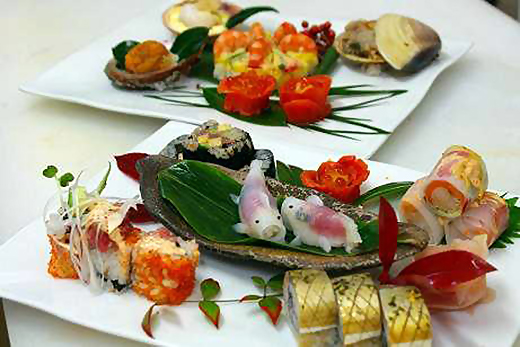
A couple of weeks back we posted an article here about the unique interpretation Ukraine has given Japan’s most iconic dish, sushi. Now, having read the insightful observations of Mr. Masayoshi Kazato, chairman for the World Sushi Cup, a competition between sushi chefs from around the world, we think it’s safe to say that not only has sushi gained footholds in all corners of the globe, each country has established its own set of regional recipes.
In countries worldwide, a sushi craze is catching on. One of the more recent nations to join in on the hype is Norway, which already had a strong industry for farmed salmon. Remember the online video of Human Sushi as an interpretive dance posted early this year? That interesting, if not disturbing, piece was created by Norwegians consumed by the craze and has reached more than 300,000 views since being uploaded last January.
And yet, Mr. Kazato would say that, relatively speaking, sushi is still in the first stages of expansion. As of right now, Japan accounts for more than 20 percent of the world’s sushi chefs. The other 80 percent are scattered throughout the world’s many other regions, particularly America, Europe, Russia, and the rest of Asia. That ratio may seem reasonable, until one remembers that Japan makes up less than two percent of the world’s population. It appears that sushi still has a lot of expanding to do.
Of course, when sushi finds footing in a new land, it does not always retain its traditional style. The means by which sushi expands into new regions and the changes it must undergo in order to match the taste palates and culinary specialties of every city or country creates a a number of evolutionary branches which result in various interpretations of sushi around the globe.
In places like Britain and Singapore, the mix of ingredients closely resembles the original Japanese type, but in countries like Germany and Israel, where avocado and mayonnaise are often added into the rolls, the sushi would be classified more as the American type. French type sushi is characterized by the inclusion of things like foie gras, pineapple, and balsamic glaze and can be found in areas such as Denmark and Belarus.
Other types of sushi are somewhat less regionally affiliated but classified according to what they contain. For example, fruit type sushi might contain mango and avocado, as is popular in Thailand. Sushi in Belgium includes their specialty chocolates to create a unique dessert type sushi with pickled tuna and a dark chocolate topping.
Of course, the contents are not the only unique things found in the many incarnations of sushi. The shape of sushi also changes according to local sensibilities. For example, many western countries are not accustomed to eating seaweed and find the sight of it unappetizing. Therefore, many of the world’s sushi restaurants will hide the seaweed inside the roll and move the rice to the outside. Color and interest might then be added using a topping of fish roe, sesame seeds, or even another layer of fish.
Tell us, what type of sushi are you most accustomed to? If you ever get the chance to travel abroad, why not find yourself a sushi bar? It may be labeled at Japanese cuisine, but really, you’re sure to find a unique embodiment of the region’s character in how they roll their fish.
Source: web R25 (Japanese)
Top image: World Sushi Cup

 Meat lovers, you can now satisfy your carnivorous cravings at this revolving sushi restaurant!
Meat lovers, you can now satisfy your carnivorous cravings at this revolving sushi restaurant! Here’s what a 10,000-yen Sushi Cake from Japan looks like
Here’s what a 10,000-yen Sushi Cake from Japan looks like Chocolate meets sushi in Kura Sushi’s Valentine’s dessert — the “Tiramisushi”
Chocolate meets sushi in Kura Sushi’s Valentine’s dessert — the “Tiramisushi” Sushi from a vending machine — would you try it? Mr. Sato did
Sushi from a vending machine — would you try it? Mr. Sato did Our Japanese-language writers taste and compare sushi from around the world
Our Japanese-language writers taste and compare sushi from around the world McDonald’s new Happy Meals offer up cute and practical Sanrio lifestyle goods
McDonald’s new Happy Meals offer up cute and practical Sanrio lifestyle goods All-you-can-drink Starbucks and amazing views part of Tokyo’s new 170 meter-high sky lounge
All-you-can-drink Starbucks and amazing views part of Tokyo’s new 170 meter-high sky lounge More foreign tourists than ever before in history visited Japan last month
More foreign tourists than ever before in history visited Japan last month Starbucks reopens at Shibuya Scramble Crossing with new look and design concept
Starbucks reopens at Shibuya Scramble Crossing with new look and design concept Beautiful Sailor Moon manhole cover coasters being given out for free by Tokyo tourist center
Beautiful Sailor Moon manhole cover coasters being given out for free by Tokyo tourist center Is the new Shinkansen Train Desk ticket worth it?
Is the new Shinkansen Train Desk ticket worth it? Randomly running into a great sushi lunch like this is one of the best things about eating in Tokyo
Randomly running into a great sushi lunch like this is one of the best things about eating in Tokyo The oldest tunnel in Japan is believed to be haunted, and strange things happen when we go there
The oldest tunnel in Japan is believed to be haunted, and strange things happen when we go there New Pikachu plushie cozies up inside ketchup bottle, looks so cute that we could eat him right up
New Pikachu plushie cozies up inside ketchup bottle, looks so cute that we could eat him right up Foreign worker in Japan fends off armed robber with single word, gets no respect from local media
Foreign worker in Japan fends off armed robber with single word, gets no respect from local media Disney princesses get official manga makeovers for Manga Princess Cafe opening in Tokyo
Disney princesses get official manga makeovers for Manga Princess Cafe opening in Tokyo We try out “Chan Ramen”, an underground type of ramen popular in the ramen community
We try out “Chan Ramen”, an underground type of ramen popular in the ramen community Beautiful new Final Fantasy T-shirt collection on the way from Uniqlo【Photos】
Beautiful new Final Fantasy T-shirt collection on the way from Uniqlo【Photos】 Foreign English teachers in Japan pick their favorite Japanese-language phrases【Survey】
Foreign English teachers in Japan pick their favorite Japanese-language phrases【Survey】 There’s a park inside Japan where you can also see Japan inside the park
There’s a park inside Japan where you can also see Japan inside the park Japanese convenience store packs a whole bento into an onigiri rice ball
Japanese convenience store packs a whole bento into an onigiri rice ball Studio Ghibli releases Kiki’s Delivery Service chocolate cake pouches in Japan
Studio Ghibli releases Kiki’s Delivery Service chocolate cake pouches in Japan Japan’s bone-breaking and record-breaking roller coaster is permanently shutting down
Japan’s bone-breaking and record-breaking roller coaster is permanently shutting down New definition of “Japanese whiskey” goes into effect to prevent fakes from fooling overseas buyers
New definition of “Japanese whiskey” goes into effect to prevent fakes from fooling overseas buyers Foreign passenger shoves conductor on one of the last full runs for Japan’s Thunderbird train
Foreign passenger shoves conductor on one of the last full runs for Japan’s Thunderbird train Our Japanese reporter visits Costco in the U.S., finds super American and very Japanese things
Our Japanese reporter visits Costco in the U.S., finds super American and very Japanese things Kyoto bans tourists from geisha alleys in Gion, with fines for those who don’t follow rules
Kyoto bans tourists from geisha alleys in Gion, with fines for those who don’t follow rules Studio Ghibli unveils Mother’s Day gift set that captures the love in My Neighbour Totoro
Studio Ghibli unveils Mother’s Day gift set that captures the love in My Neighbour Totoro Domino’s Japan now sells…pizza ears?
Domino’s Japan now sells…pizza ears? New Japanese KitKat flavour stars Sanrio characters, including Hello Kitty
New Japanese KitKat flavour stars Sanrio characters, including Hello Kitty Sales of Japan’s most convenient train ticket/shopping payment cards suspended indefinitely
Sales of Japan’s most convenient train ticket/shopping payment cards suspended indefinitely Sold-out Studio Ghibli desktop humidifiers are back so Totoro can help you through the dry season
Sold-out Studio Ghibli desktop humidifiers are back so Totoro can help you through the dry season Japanese government to make first change to romanization spelling rules since the 1950s
Japanese government to make first change to romanization spelling rules since the 1950s Ghibli founders Toshio Suzuki and Hayao Miyazaki contribute to Japanese whisky Totoro label design
Ghibli founders Toshio Suzuki and Hayao Miyazaki contribute to Japanese whisky Totoro label design Doraemon found buried at sea as scene from 1993 anime becomes real life【Photos】
Doraemon found buried at sea as scene from 1993 anime becomes real life【Photos】 Tokyo’s most famous Starbucks is closed
Tokyo’s most famous Starbucks is closed One Piece characters’ nationalities revealed, but fans have mixed opinions
One Piece characters’ nationalities revealed, but fans have mixed opinions We asked a Uniqlo employee what four things we should buy and their suggestions didn’t disappoint
We asked a Uniqlo employee what four things we should buy and their suggestions didn’t disappoint Princesses, fruits, and blacksmiths: Study reveals the 30 most unusual family names in Japan
Princesses, fruits, and blacksmiths: Study reveals the 30 most unusual family names in Japan Studio Ghibli’s new desktop Howl’s Moving Castle will take your stationery on an adventure
Studio Ghibli’s new desktop Howl’s Moving Castle will take your stationery on an adventure Which Japanese conveyor belt sushi chain has the best egg sushi?【Taste test】
Which Japanese conveyor belt sushi chain has the best egg sushi?【Taste test】 Is it gross to eat sushi that the chef pressed with his bare hands?【Survey】
Is it gross to eat sushi that the chef pressed with his bare hands?【Survey】 Supermarket sushi becomes a hot topic with foreigners on Reddit, but is it any good?
Supermarket sushi becomes a hot topic with foreigners on Reddit, but is it any good? Japan’s oldest sushi train serves up unorthodox Blueberry Cream Sushi
Japan’s oldest sushi train serves up unorthodox Blueberry Cream Sushi Our Japanese-born reporter gets some culture shock at Mexico City’s most popular sushi chain
Our Japanese-born reporter gets some culture shock at Mexico City’s most popular sushi chain Takoyaki sushi rolls at popular Japanese chain take California rolls to a whole new level
Takoyaki sushi rolls at popular Japanese chain take California rolls to a whole new level Tokyo’s all-female sushi chef restaurant has closed down, is being dismantled
Tokyo’s all-female sushi chef restaurant has closed down, is being dismantled Sushi Wine doesn’t pair well with raw fish, but we’re still going to buy another bottle
Sushi Wine doesn’t pair well with raw fish, but we’re still going to buy another bottle Tokyo has a BLUE sushi restaurant with all-you-can-eat BLUE sushi for just 400 yen (US$3.50)
Tokyo has a BLUE sushi restaurant with all-you-can-eat BLUE sushi for just 400 yen (US$3.50) There’s only one place in Japan where this kind of sushi isn’t red, but why?
There’s only one place in Japan where this kind of sushi isn’t red, but why? Nadeshico Sushi restaurant challenges gender roles with all-female staff clad in kimono
Nadeshico Sushi restaurant challenges gender roles with all-female staff clad in kimono Our writer tries out Hong Kong’s ‘killer sushi’, lives to tell the tale
Our writer tries out Hong Kong’s ‘killer sushi’, lives to tell the tale Which Japanese conveyor belt sushi chain has the best hamburger steak sushi?【Taste test】
Which Japanese conveyor belt sushi chain has the best hamburger steak sushi?【Taste test】 How to have a great meal at conveyer belt sushi chain Kura Sushi even if you hate raw fish
How to have a great meal at conveyer belt sushi chain Kura Sushi even if you hate raw fish We try a frozen sushi box from Rejyu, and it was way better than it sounds
We try a frozen sushi box from Rejyu, and it was way better than it sounds Conveyor belt sushi chain taking the bold, eco-friendly step of getting rid of all its conveyors
Conveyor belt sushi chain taking the bold, eco-friendly step of getting rid of all its conveyors
Leave a Reply